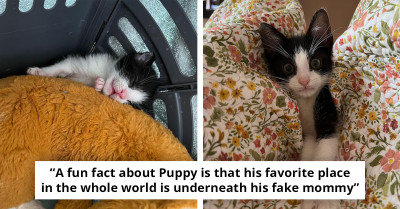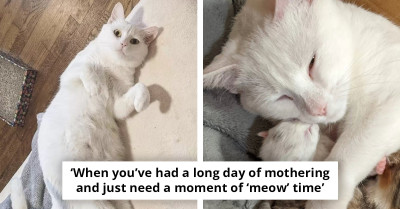
Meet B-Man: A Rescue Cat With The Most Adorable Wobbly Walk
He's got the moves alright...

We all expect cats to be fast and dexterous. It is their thing.
Without it, they are just... Well, we have proof that they are awesome even without their athletic abilities.
This video of B-Man, the cutest little cat we've ever seen, tipping and tapping around his home is the best proof. Now, he's got the moves, but not like the ones you would expect from a cat.
Namely, he wobbles around and he is adorable in his clumsiness. After learning more about his situation, it was discovered that he has Cerebellar Hypoplasia (CH).
But, to be honest, it doesn't appear that the little man is suffering from it all that much. Cerebellar Hypoplasia is a neurological disorder in which the brain and muscles are unable to communicate effectively.
This makes it difficult for cats to maintain their posture and balance. B-man, his mother, and the remainder of their litter were rescued.
A mommy cat, along with a few other stray cats, showed up at her new hooman's house one day. They pleaded for food, affection, and medicine, and they got all they wanted.
After a while, the mother cat gained confidence in the hooman and allowed her to see her young kittens. The kittens were hidden in a mass of garbage and filth, and the hooman knew she had to rescue them.
Let's get to know them better.
This is B-Man, the wobbliest cat on TikTok
Cerebellar hypoplasia is a brain development disorder in which the cerebellum fails to grow normally. The cerebellum is a part of the brain that is in charge of fine motor abilities, balance, and coordination.
The illness is not unpleasant nor communicable. Cerebellar hypoplasia is most usually caused by a pregnant cat contracting the feline panleukopenia virus and infecting her unborn kittens.
The panleukopenia virus targets quickly dividing cells first. The cerebellum undergoes rapid growth and development during the perinatal period (i.e., the last weeks of pregnancy and the first weeks after delivery), making it prone to virus infection.
The illness can affect just one kitten in a litter or it can impact the entire litter.
about B-Man's condition
Their story:
The signs of this illness may not become obvious until the kitten tries to stand or walk on its own, as the cerebellum is crucial for deliberate movement and coordination. The severity of the symptoms is determined by how much of the cerebellum was injured and when the infection happened in its development.
Jerky or disorganized walking, swaying from side to side when trying to walk, and a goose-stepping gait called hypermetria are the most common symptoms.
His mom got a rug for the hallway to make it less slippery.
B-Man and his family were rescued from a family of cat hoarders. They were keeping the cats in unsanitary conditions and feeding them badly and rarely.
The members of the family were even threatening worried neighbors who tried to feed the cats or help them in some other way. B-man was very fortunate to find a loving home.
We hope that the rest of the cats will be rescued too.
Damjan







